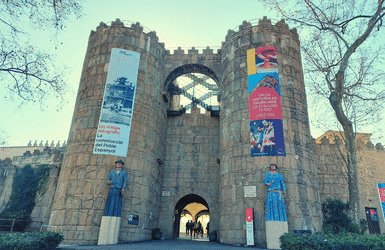
[ad_1]
/*! elementor – v3.11.3 – 07-03-2023 */
.elementor-widget-image{text-align:center}.elementor-widget-image a{display:inline-block}.elementor-widget-image a img[src$=”.svg”]{width:48px}.elementor-widget-image img{vertical-align:middle;display:inline-block}
/*! elementor – v3.11.3 – 07-03-2023 */
.elementor-heading-title{padding:0;margin:0;line-height:1}.elementor-widget-heading .elementor-heading-title[class*=elementor-size-]>a{color:inherit;font-size:inherit;line-height:inherit}.elementor-widget-heading .elementor-heading-title.elementor-size-small{font-size:15px}.elementor-widget-heading .elementor-heading-title.elementor-size-medium{font-size:19px}.elementor-widget-heading .elementor-heading-title.elementor-size-large{font-size:29px}.elementor-widget-heading .elementor-heading-title.elementor-size-xl{font-size:39px}.elementor-widget-heading .elementor-heading-title.elementor-size-xxl{font-size:59px}
THE SPANISH VILLAGE IN BARCELONA
Poble Espanyol (in English Spanish Village, in Spanish Pueblo Español) is one of the top attractions of the Hill of Montjuic in Barcelona, and also one of the most versatile. Some may want to visit it for the scenic spots and fun instagramable photo opportunities. Other will go for the unique handcraft gifts and souvenirs that you can’t find anywhere else in town. Some will go for the flamenco show, or the nightlife, or the contemporary art. Or even the many events, festivals and family activities that are organized there regularly. What’s your reason to visit Pueblo Español?
History and concept of the Pueblo Español
/*! elementor – v3.11.3 – 07-03-2023 */
.elementor-widget-image-box .elementor-image-box-content{width:100%}@media (min-width:768px){.elementor-widget-image-box.elementor-position-left .elementor-image-box-wrapper,.elementor-widget-image-box.elementor-position-right .elementor-image-box-wrapper{display:flex}.elementor-widget-image-box.elementor-position-right .elementor-image-box-wrapper{text-align:right;flex-direction:row-reverse}.elementor-widget-image-box.elementor-position-left .elementor-image-box-wrapper{text-align:left;flex-direction:row}.elementor-widget-image-box.elementor-position-top .elementor-image-box-img{margin:auto}.elementor-widget-image-box.elementor-vertical-align-top .elementor-image-box-wrapper{align-items:flex-start}.elementor-widget-image-box.elementor-vertical-align-middle .elementor-image-box-wrapper{align-items:center}.elementor-widget-image-box.elementor-vertical-align-bottom .elementor-image-box-wrapper{align-items:flex-end}}@media (max-width:767px){.elementor-widget-image-box .elementor-image-box-img{margin-left:auto!important;margin-right:auto!important;margin-bottom:15px}}.elementor-widget-image-box .elementor-image-box-img{display:inline-block}.elementor-widget-image-box .elementor-image-box-title a{color:inherit}.elementor-widget-image-box .elementor-image-box-wrapper{text-align:center}.elementor-widget-image-box .elementor-image-box-description{margin:0}

Barcelona celebrated its second World Fair in 1929. The first one had taken place in 1888 in the Ciutadella Park, and now it was the turn of the Montjuic Hill. It was a time when travel wasn’t easy and the organizers decided to create an enclosure that could transport visitors around Spain in a short amount of time. It’d be a space shaped as a village: with its real-size buildings, its streets, its plazas… But where the buildings replicated the traditional styles and representative buildings of each region of Spain.
A small team of artists and intellectuals led by the painter Miguel Utrillo (member of the central core of modernist artists of Barcelona) were sent on a tour around the country, visiting over 1600 villages, towns and cities to gather ideas and chose the architectural elements that were worth including in the project. The result was conceived to look real, well integrated, and coherent. The buildings would be placed together considering its original location, style and materials, in a way that the transition from one to the other felt natural, even if that meant introducing changes in the final structure compared to the original.
The Spanish Village was meant to be an attraction built just for the World Fair, and then be demolished like most of the rest of the fair structures. However, the quality of the construction and its popularity led to saving it. After years of ups and downs, the Poble Espanyol has managed to define its personality as a cultural center and an outdoor museum with charm.
[ad_2]
Source link